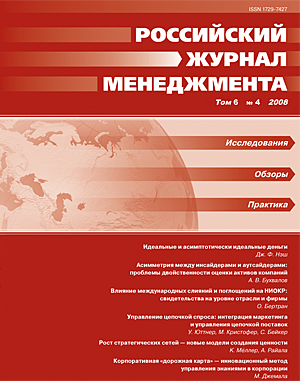The New Directions of Network Management Studies
Downloads
Download data is not yet available.
References
ЛИТЕРАТУРА НА РУССКОМ ЯЗЫКЕ
Мёллер К., Райала А. 2008. Рост стратегических сетей — новые модели создания ценности. Российский журнал менеджмента 6 (4): 113–140.
Третьяк О. А., Румянцева М. Н. 2003. Сете вые формы межфирменной кооперации: подходы к объяснению феномена. Российский журнал менеджмента 1 (2): 77–102.
Юттнер У., Кристофер М., Бейкер С. 2008. Управление цепочкой спроса: интеграция маркетинга и управления цепочкой по ставок. Российский журнал менеджмента 6 (4): 83–112.
REFERENCES IN LATIN ALPHABET
Achrol R. 1991. Evolution of the marketing organization: New forms for dynamic environments. Journal of Marketing 55 (10): 77–93.
Achrol R. 1997. Chances in the theory of interorganizational relations in marketing: Toward a network paradigm. Journal of the Academy of Marketing Science 25 (1): 56–71.
Achrol R. S., Kotler P. 1999. Marketing in the network economy. Journal of Marketing 63 (4, Special issue): 146–163.
Benton W. C., Maloni M. 2005. The influence of power driven buyer/seller relationships on supply chain satisfaction. Journal of Operations Management 23 (1): 1–22.
Berry L. L. 1983. Relationship marketing. In: Berry L. L., Shostack G. L., Upah G. D. (eds.). Emerging Perspectives On Services Marketing. American Marketing Association: Chicago, IL; 25–38.
Bradach L. B., Eccles R. G. 1989. Price, authority, and trust: From ideal types to plural forms. Annual Review of Sociology 15: 97–118.
Brandenburger A. M., Nalebuff B. J. 1996. Coopetition. Doubleday: N. Y.
Corsten D., Kumar N. 2005. Do suppliers benefit from collaborative relationships with large retailers? An empirical investigation of efficient consumer response adoption. Journal of Marketing 69 (3): 80–94.
Cox A. 2004. The art of the possible: Relationship management in power regimes and supply chains. Supply Chain Management: An International Journal 9 (5): 346–356.
Cravens D. W., Piercy N. F., Shipp S. H. 1996. New organizational forms for competing in highly dynamic environments: The network paradigm. British Journal of Management 7 (3): 203–218.
Elg U. 2002. Inter-fi rm market orientation: Its signifi cance and antecedents in distribution networks. Journal of Marketing Management 18 (7/8): 633–655.
Fisher M. 1997. What is the right supply chain for your product? Harvard Business Review 76 (2): 105–116.
Håkansson H. (ed.). 1982. Internal Marketing and Purchasing of Industrial Goods — An Interaction Approach. Wiley: N. Y.
Håkansson H., Ford D. 2002. How should companies interact in business environments. Journal of Business Research 55 (2): 133–139.
Håkansson H., Snehota I. 1989. No business is an island: The network concept of business strategy. Scandinavian Journal of Management 5 (3): 187–200.
Jarillo J. C. 1988. On strategic networks. Strategic Management Journal 9 (1): 31–41.
Jeong Jung Sik, Hong P. 2007. Customer orientation and performance outcomes in supply chain management. Journal of Enterprise Information Management 20 (5): 578–594.
Jüttner U., Christopher M., Baker S. 2007. Demand chain management-integrating marketing and supply chain management. Industrial Marketing Management 36 (5): 377–392.
Kasabov E. 2007. Towards a contingent, empirically validated, and power cognisant relationship marketing. European Journal of Marketing 41 (1/2): 94–120.
Kohli A., Jaworski B. 1990. Market orientation: The construct, research propositions and managerial implications. Journal of Marketing 54 (2): 1–18.
Miles R. E., Snow C. C. 1986. Network organizations: New concepts for new forms. California Management Review 28 (3): 62–73.
Möller K., Svahn S. 2003. Managing strategic nets: A capability perspective. Marketing Theory 3 (2): 201–226.
Narver J., Slater S. 1990. The effects of market orientation on profitability. Journal of Marketing 54 (4): 20–35.
Oliver R. K., Webber M. D. 1982. Supply chain management: Logistics catches up with strategy. Outlook, reprinted in: Christopher M. 1992. Logistics: The Strategic Issues. Chapman Hall: London; 63–75.
Parolini C. 1999. The Value Net: A Tool for Competitive Strategy. John Wiley & Sons: Chichester, UK.
Polanyi K. 1957. The economy as instituted process. In: Polanyi K., Arensberg C., Pearson H. (eds.). Trade and Market in the Early Empires; Economies in History and Theory. Free Press: Glencoe, IL.
Porter M. E. 1985. Competitive Advantage: Creating and Sustaining Superior Performance. Free Press: N. Y.
Powell W. W. 1987. Hybrid organizational arrange ments: New form or transitional development? California Management Review 30 (1): 67–87.
Rainbird M. 2004. Demand and supply chains: The value catalyst. International Journal of Physical Distribution Logistics Management 34 (3/4): 230–250.
Slater C. C. et al. 1965–1974. LAFS/LAMP Research Reports. East Lansing.
Snow C. C., Miles R. E, Coleman H. J. 1992. Managing 21st century network organizations. Organization Dynamics 20 (3): 5–20.
Varamäki E., Vesalainen J. 2003. Modelling different types of multilateral co-operation between SMEs. Entrepreneurship & Regional Development 15 (1): 27–47.
Vollmann T., Cordon C., Raabe H. 1995. From Supply Chain Management to Demand Chain Management. IMD Perspectives for Managers, November.
Downloads
Published
2008-12-09
How to Cite
Popov, N. I., & Tretyak, O. A. (2008). The New Directions of Network Management Studies. Russian Management Journal, 6(4), 75–82. Retrieved from https://rjm.spbu.ru/article/view/488
Issue
Section
Discussions: New Concepts of Management in Networks
License
Articles of the Russian Management Journal are open access distributed under the terms of the License Agreement with Saint Petersburg State University, which permits to the authors unrestricted distribution and self-archiving free of charge.





